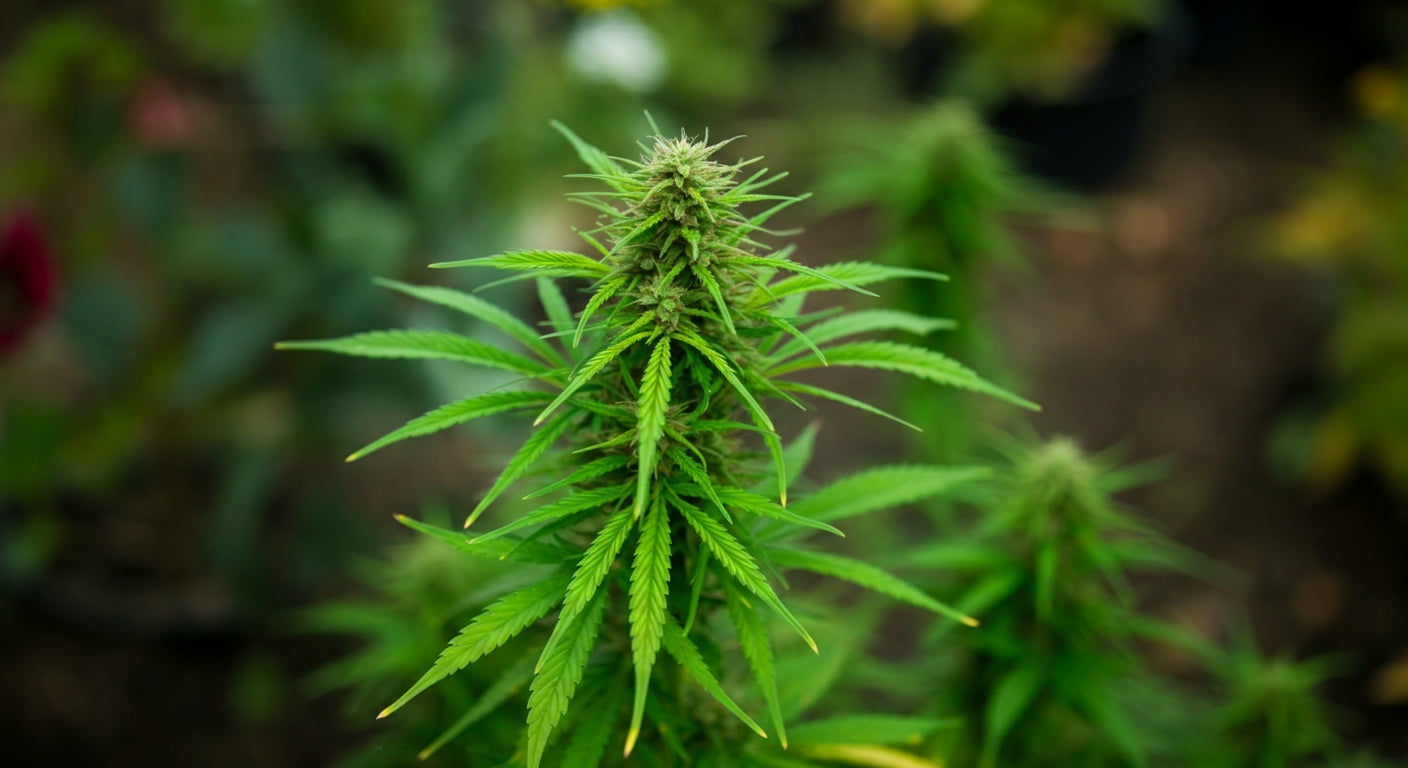
How Long Does Weed Take to Grow? Your Complete Cannabis Timeline Guide
Quick Answer: Cannabis typically takes 3-6 months to grow from seed to harvest. This includes 3-7 days germination, 2-3 weeks seedling stage, 4-8 weeks vegetative growth, 8-12 weeks flowering, plus 1-2 weeks drying. Autoflowering strains finish faster at 10-14 weeks total, while photoperiod strains can be extended longer for bigger yields.
Understanding cannabis growing timelines is essential for planning successful harvests, managing expectations, and optimizing your growing schedule. Whether you're a first-time grower or planning multiple harvests throughout the year, knowing exactly what to expect at each stage helps you make better decisions and achieve consistent results.
This guide breaks down each phase of cannabis development, reveals factors that speed up or slow down growth, and provides expert strategies for optimizing your timeline without sacrificing quality.
Complete Cannabis Growing Timeline Breakdown
Cannabis cultivation follows predictable phases, each with specific duration ranges and requirements. Understanding these stages helps you plan equipment needs, schedule activities, and anticipate harvest timing.
Phase 1: Germination (3-7 Days) Seeds crack open and develop initial taproots during this critical first stage. Healthy seeds typically show signs of life within 24-48 hours under optimal conditions (warm, moist, dark environment).
Success factors for faster germination:
- Temperature: 75-80°F (24-27°C) consistently
- Humidity: 70-80% relative humidity
- Method: Paper towel method or direct planting in starter cubes
- Quality: Fresh, properly stored seeds germinate fastest
Phase 2: Seedling Stage (2-3 Weeks) Young plants develop their first sets of true leaves and establish root systems. This delicate stage requires gentle conditions and careful attention to prevent stress that could slow development.
Critical seedling requirements:
- Light: 18-24 hours daily with gentle intensity
- Temperature: 70-75°F (21-24°C) for optimal growth
- Humidity: 65-70% to prevent moisture stress
- Environment: Controlled grow tent conditions provide ideal stability
Phase 3: Vegetative Growth (4-8 Weeks) Plants experience rapid vertical and lateral growth, developing the structure needed to support future flower production. This phase can be extended indefinitely under 18/6 lighting to increase plant size and yield potential.
Phase 4: Flowering (8-12 Weeks) Triggered by switching to 12/12 lighting (or occurring automatically in autoflowering strains), plants develop flowers and resin production peaks. This is typically the longest phase of cultivation.
Phase 5: Harvest and Processing (2-4 Weeks) After harvest, proper drying (1-2 weeks) and curing (2-8 weeks) are essential for quality cannabis. While not technically "growing," this processing time affects your overall timeline planning.

Autoflowering vs Photoperiod: Timeline Differences
The genetics you choose dramatically impact your growing timeline, with autoflowering and photoperiod strains following completely different scheduling patterns.
Autoflowering Cannabis Timelines Autoflowering strains complete their entire lifecycle in 10-14 weeks regardless of lighting schedule, making them ideal for quick harvests and beginner growers.
Typical autoflowering schedule:
- Germination: 3-7 days
- Seedling: 1-2 weeks
- Vegetative: 2-4 weeks (automatic transition)
- Flowering: 6-8 weeks
- Total timeline: 10-14 weeks
Advantages for timeline planning:
- Predictable harvest dates for continuous production
- Multiple harvests per year (4-5 cycles annually)
- No need to adjust lighting schedules
- Faster turnaround for testing new genetics
Photoperiod Cannabis Timelines Photoperiod strains offer more control over timing but require specific lighting schedules to trigger flowering, allowing for extended vegetative periods and larger plants.
Flexible photoperiod schedule:
- Germination: 3-7 days
- Seedling: 2-3 weeks
- Vegetative: 4-16+ weeks (grower controlled)
- Flowering: 8-12 weeks (strain dependent)
- Total timeline: 4-7 months
Timeline control benefits:
- Extend vegetative growth for larger yields
- Time harvests for optimal seasonal conditions
- Clone mother plants for consistent genetics
- Coordinate multiple tent harvests
Environmental Factors That Speed Up or Slow Growth
Environmental conditions directly impact how quickly cannabis develops through each growth phase. Optimizing these factors can reduce total growing time by 20-30% while improving quality.
Temperature Optimization for Faster Growth Maintaining optimal temperatures throughout each phase accelerates metabolic processes and nutrient uptake:
- Germination: 75-80°F (24-27°C) for fastest emergence
- Seedling: 70-75°F (21-24°C) prevents stress slowdowns
- Vegetative: 75-85°F (24-29°C) maximizes growth rates
- Flowering: 70-80°F (21-27°C) optimizes resin production
Professional environmental control maintains these precise ranges automatically, preventing temperature-related growth delays.
Humidity Management for Phase-Specific Growth Proper humidity levels prevent stress and disease while supporting optimal plant function:
- Early stages: 65-70% RH supports healthy development
- Mid-vegetative: 50-60% RH prevents mold while maintaining growth
- Late flowering: 40-50% RH enhances resin production
Lighting Intensity and Spectrum Impact High-quality LED grow lights with proper spectrum control accelerate photosynthesis and development:
- Seedlings: 200-400 PPFD prevents light stress
- Vegetative: 400-600 PPFD maximizes growth rates
- Flowering: 600-1000 PPFD optimizes flower development
Nutrition Timing for Accelerated Growth Balanced feeding schedules prevent deficiencies that slow development:
- Early stages: Light feeding prevents nutrient burn
- Vegetative: Nitrogen-rich nutrients support rapid growth
- Flowering: Phosphorus and potassium boost flower development

Growing Method Impact on Timeline
Different cultivation techniques significantly affect how long cannabis takes to grow, with some methods accelerating development while others extend timelines for increased yields.
Soil vs Hydroponic Growth Rates Growing medium choice impacts nutrient availability and root development speed:
Soil growing characteristics:
- Slower nutrient uptake extends timelines slightly
- Buffer effect prevents rapid pH swings
- Organic feeding may extend vegetative periods
- More forgiving for beginners
Hydroponic advantages:
- 20-30% faster growth rates possible
- Direct nutrient access accelerates development
- Precise feeding control optimizes each phase
- Professional hydroponic systems maximize efficiency
Training Techniques and Timeline Effects Plant training methods can extend vegetative periods but increase final yields:
Low Stress Training (LST): Adds 1-2 weeks to vegetative stage but increases yield 20-40% SCROG (Screen of Green): May extend vegetative by 2-4 weeks for significant yield increases Topping and Fimming: Brief recovery periods but create more flowering sites Trellis netting support: Supports heavy branches without extending timelines
Sea of Green (SOG) for Faster Harvests SOG technique uses many small plants flowered early, reducing total timeline:
- Minimal vegetative time (2-3 weeks)
- Earlier flowering triggers (at 12-18 inches)
- More frequent harvests with smaller individual yields
- Ideal for continuous production systems
Advanced Timeline Optimization Strategies
Professional growers use specific techniques to minimize growing time while maintaining or improving quality and yields.
Genetic Selection for Speed Choosing fast-finishing genetics reduces overall timeline:
- Indica-dominant strains: 7-9 week flowering periods
- Fast versions: Specially bred for quick finishing
- Autoflowering hybrids: Combine speed with potency
- Clone selection: Proven fast-growing phenotypes
Environmental Acceleration Techniques Fine-tuning conditions can safely speed development:
- CO2 supplementation: 20-30% faster growth in sealed environments
- Optimal VPD management: Maximizes transpiration and nutrient uptake
- Light cycle manipulation: Strategic lighting adjustments
- Temperature differential: Day/night temperature variations
Perpetual Harvest Systems Multiple tent setups enable continuous production:
- Stagger planting dates for regular harvests
- Dedicate tents to specific growth phases
- Maintain mother plants for consistent clones
- Optimize space utilization across multiple cycles
Quick Turnaround Techniques Minimize downtime between harvests:
- Pre-prepared growing medium ready for immediate transplant
- Advanced seedling preparation while previous crop finishes
- Efficient harvest processing reduces post-harvest timeline
- Environmental system maintenance prevents delays
Strain-Specific Timeline Variations
Different cannabis strains have dramatically different flowering times and growth characteristics that affect total cultivation duration.
Indica Strain Timelines Indica-dominant genetics typically finish fastest:
- Flowering period: 7-9 weeks average
- Growth pattern: Shorter, bushier plants
- Popular fast strains: Northern Lights (7-8 weeks), Hindu Kush (8 weeks)
- Total timeline: 3.5-4.5 months from seed
Sativa Strain Considerations Sativa genetics often require longer flowering periods:
- Flowering period: 10-14 weeks common
- Growth pattern: Taller plants need more space
- Extended timelines: Plan for 5-6 months total
- Yield compensation: Longer flowering often means higher yields
Hybrid Strain Balance Modern hybrids offer balanced timelines and characteristics:
- Flowering period: 8-11 weeks typical
- Growth balance: Medium height with good yields
- Timeline predictability: More consistent than pure genetics
- Popular options: Most commercial strains fall in this category
Autoflowering Strain Variations Even autoflowering genetics vary in total timeline:
- Fast autos: 8-10 weeks total (some specialty genetics)
- Standard autos: 10-12 weeks typical
- Larger autos: 12-14 weeks for bigger plants
- Super autos: 14-16 weeks for maximum yields
Common Timeline Problems and Solutions
Understanding potential delays helps prevent timeline disruptions and keeps harvests on schedule.
Germination Delays Problem: Seeds taking 7+ days to germinate or showing poor germination rates Causes: Old seeds, poor storage, incorrect temperature/humidity Solutions: Use fresh genetics, optimize germination environment, pre-soak difficult seeds
Slow Vegetative Growth Problem: Plants showing minimal growth after several weeks Causes: Poor lighting, nutrient deficiencies, environmental stress, root problems Solutions: Upgrade lighting intensity, adjust nutrition, optimize environment, check root health
Extended Flowering Times Problem: Plants not finishing when expected, clear trichomes persisting Causes: Environmental stress, poor genetics, inadequate lighting during flower Solutions: Maintain stable conditions, ensure adequate flowering light intensity, be patient with genetics
Environmental Disruptions Problem: Heat waves, power outages, or equipment failures disrupting growth Causes: External factors, equipment malfunctions, inadequate backup systems Solutions: Professional monitoring systems, backup equipment, environmental controls
Planning Multiple Harvests
Strategic planning enables multiple harvests per year while maintaining quality and avoiding legal limits in applicable jurisdictions.
Staggered Planting Schedules Plan new plants every 4-6 weeks for continuous harvests:
- Autoflower rotation: New plants every month
- Photoperiod stagger: Every 6-8 weeks depending on vegetative time
- Mixed approaches: Combine fast and slow genetics
Seasonal Considerations Indoor growing eliminates seasonal limitations but energy costs vary:
- Winter growing: Lower cooling costs but higher heating needs
- Summer challenges: Increased cooling requirements
- Shoulder seasons: Optimal for energy efficiency
Equipment Rotation and Maintenance Plan maintenance around growing cycles:
- Deep cleaning between harvests
- Equipment upgrades during downtime
- System optimization based on previous results
FAQ Section
How long does weed take to grow indoors vs outdoors? Indoor cannabis typically takes 3-6 months from seed to harvest with complete environmental control. Outdoor cannabis follows natural seasons, planted in spring for fall harvest (6-8 months total), but timing depends on local climate and daylight cycles.
What's the fastest way to grow weed? Use autoflowering genetics (10-14 weeks total), optimize environmental conditions with professional equipment, choose fast-finishing indica strains, and maintain ideal temperature, humidity, and lighting throughout all phases for maximum growth rates.
Can you speed up cannabis flowering time? You cannot safely speed up the biological flowering process, but you can optimize conditions to ensure plants finish on time. Maintain proper temperature, lighting intensity, and nutrients. Some growers use techniques like light stress, but these risk reducing quality.
How long is the vegetative stage for weed? Vegetative stage length varies by growing goals: autoflowers (2-4 weeks fixed), photoperiod strains (4-8 weeks typical, but can be extended indefinitely). Longer vegetative periods generally produce larger plants and higher yields.
Do bigger pots make weed grow faster? Bigger pots don't make plants grow faster, but they prevent root binding that can slow growth. Right-sized containers for each phase optimize growth: small containers for seedlings, medium for vegetative, large for flowering or extended growth.
How often can you harvest weed per year? Indoor growing allows 3-5 autoflower harvests annually or 2-3 photoperiod harvests. Perpetual harvest systems with multiple tents enable monthly harvests. Outdoor growing typically allows one harvest per season in most climates.
What factors slow down weed growth the most? Environmental stress (wrong temperature/humidity), inadequate lighting, nutrient problems, poor genetics, and root issues cause the biggest growth delays. Professional equipment and monitoring prevent most slowdowns while ensuring optimal development.
Summary
Key Takeaways: Cannabis growing timelines range from 10-14 weeks for autoflowers to 4-7 months for photoperiod strains. Environmental optimization, proper genetics selection, and professional equipment significantly impact growth speed while maintaining quality. Plan for multiple harvests annually using staggered planting and perpetual harvest techniques.
Optimize your cannabis growing timeline with professional grow tent systems designed for consistent, predictable results. From precision environmental monitoring to complete growing kits, every component works together for maximum efficiency and quality.
Ready to start your cannabis growing journey? Explore our beginner grow tent setups and complete growing systems designed for successful cultivation from seed to harvest.
Learn more about cannabis cultivation with our comprehensive guides on complete growing timelines, home growing setup, and timeline optimization strategies.

Lena Myles
I'm a mushroom enthusiast and home cook based in Oregon. I'm passionate about foraging and creating fungi-focused recipes, especially delicious, plant-based dishes using gourmet mushrooms like trumpet, shiitake, and oyster. When I’m not in the kitchen, you’ll usually find me wandering the woods in search of new wild flavors.


